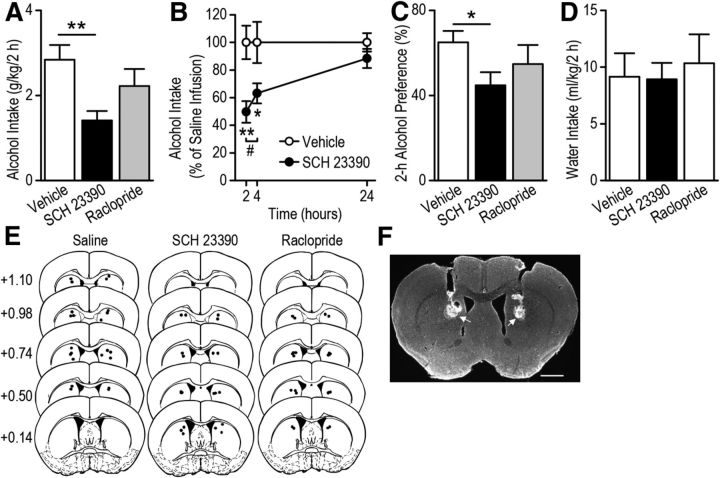Figure 7.
Intra-DMS infusion of a D1R antagonist causes a reduction of alcohol consumption. The D1R antagonist SCH 23390 (0.5 μg), D2R antagonist raclopride (4 μg), or vehicle (saline) was bilaterally infused into the DMS of C57BL/6 mice 5 min before the start of a drinking session, and alcohol intake was measured 2, 4, and 24 h later. A, Intra-DMS infusion of SCH 23390, but not of raclopride, leads to a decrease in 2 h alcohol-drinking session; **p < 0.01, one-way ANOVA. B, SCH 23390 infusion causes a time-dependent reduction in alcohol intake; **p < 0.01 versus Vehicle at 2 h; *p < 0.05 versus Vehicle at 4 h; #p < 0.05, two-way RM-ANOVA followed by SNK tests. C, Intra-DMS infusion of SCH 23390, but not raclopride, produces a decrease in preference for 2 h alcohol intake; *p < 0.05, one-way ANOVA. D, Intra-DMS infusion of SCH 23390 or of raclopride does not alter 2 h water intake. E, Schematic representation of the injection cannula placements. The location of the injector tips is represented by black circles for Vehicle (left), SCH 23390 (middle), and raclopride (right) infusions. F, Sample image showing the placement of injection cannulae as indicated by arrowheads. Scale bar, 1 mm. n = 11 (Vehicle), 10 (SCH 23390), and 11 (raclopride).

